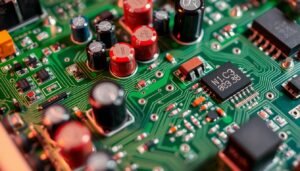Introduction
Electrical devices have become indispensable in our day-to-day existence in this age of technology. Nonetheless, these devices are not impervious to problems, which frequently originate from their electronic components. Gaining comprehension of and resolving these prevalent issues may be crucial in guaranteeing the durability and peak functionality of your devices. This manual will assist the reader in resolving common problems associated with electronic components through the use of workable solutions.
Identification of Indicators of Component Failure
Power Problems
Power-related issues are among the most discernible indications of component failure. This may materialize in the form of a device that fails to power on, undergoes frequent power outages, or fails to charge properly. These complications frequently indicate issues with the battery, power supply, or associated circuits.
Components Overheating
A frequent occurrence in numerous electronic devices is overheating. There are several potential causes for this issue, such as malfunctioning cooling systems, processors that are overburdened, or environmental conditions. Prolonged periods of overheating have the potential to cause harm to components and diminish the lifespan of devices.
Atypical Sounds
The operation of electronic devices ought to be relatively quiet. The presence of buzzing, clicking, or whirring noises may suggest an internal component malfunction, including issues with the hard drive, fans, or capacitors.
Methods for Diagnosing and Resolving Issues
Visual Examination
Visually scrutinize the device initially. Examine the circuit board for any indications of physical harm, including fractures, burns, or corrosion. Additionally, inspect for damaged or unsecured connections.
Cleaning the Components
Over time, the accumulation of dust and detritus can lead to overheating or short circuits. By consistently cleansing the components with the appropriate equipment and methods, numerous common problems can be averted.
Evaluation Utilizing Multimeters
Multimeters are indispensable tools in the process of diagnosing electrical issues. By examining components for continuity, voltage levels, and resistance, they aid in identifying the source of a problem.
Frequent Challenges and Resolutions
Issues with the battery and power supply
Before attempting to repair a power issue with your device, inspect the battery or power supply. Utilize a multimeter to verify that the power supply unit is delivering the appropriate voltage or to replace the battery.
Fixing Problems with Overheating
To address issues related to overheating, verify the proper functioning of cooling mechanisms such as ventilation and heat sinks. If your device is susceptible to overheating, consider utilizing additional cooling solutions and applying thermal paste where required.
Securing Resolutions for Sound Challenges
Unusual sounds frequently emanate from mechanical components such as hard drives or fans. Examine these components for wear or damage, and replace as required. Examine capacitors for signs of failure, such as bulging or leakage, and replace them as necessary.
Best Practices and Preventive Measures
Routine Maintenance
Consistent maintenance is vital for the prevention of problems. This includes performing hardware inspections, software updates, and cleansing.
Implementation of Quality Components
By investing in high-quality components, the probability of failure can be reduced substantially. Although less expensive options may entice one, they frequently result in increased frequency of issues and replacements.
Environmental Considerations
The operational environment of a device can have a significant impact on its efficacy. Dust, moisture, and extreme temperatures should be avoided at all costs in order to prevent potential problems.
Sophisticated Troubleshooting Methods
Updates to Firmware and Software
Occasionally, the software, not the hardware, is the source of the problem. Ensure the firmware and software of your device are current, as doing so can resolve a number of performance issues.
Soldering and Replacement of Components
Soldering can be employed by more proficient individuals to rectify or substitute defective components. Although it demands dexterity and knowledge of electronics, this may prove to be an economical resolution for specific challenges.
Difficult Repairs
Although certain problems may be resolved without professional assistance, the majority of issues can be resolved at home. If you are unable to perform complex repairs or lack the required equipment, you should consult a professional.
Insurance and Warranty
Before beginning any repairs, verify whether or not the device is insured or covered by a warranty. DIY remedies frequently void warranties; therefore, this should be carefully considered prior to proceeding.
Conclusion
Resolving problems and conducting troubleshooting on electronic components within devices can present a gratifying endeavor. One can optimize device longevity and prevent expensive device replacements by acquiring knowledge regarding prevalent issues and effective solutions.
It is advisable to seek professional assistance for complex issues, even though do-it-yourself projects can be effective. You can acquire the skills and knowledge necessary to effectively maintain and repair your electronic devices, thereby ensuring their continued optimal operation for many years.
